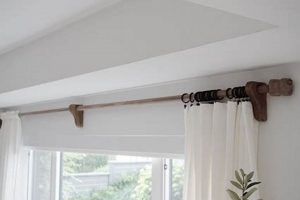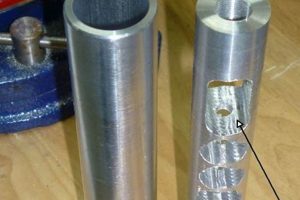A collection of pre-cut, measured, and sometimes pre-assembled materials intended for the construction of an outdoor storage structure. These sets typically include lumber, hardware, roofing materials, and detailed instructions, facilitating the assembly of a functional garden building. As an example, a homeowner might purchase a prefabricated package containing all necessary components, allowing them to erect a storage space for tools and equipment over a weekend.
These sets provide a cost-effective and convenient solution for acquiring additional outdoor storage. The utilization of such a package reduces construction time and labor expenses associated with sourcing individual materials and cutting them to the appropriate dimensions. Historically, these kits gained popularity as homeowners sought efficient ways to improve property value and organization without the complexities of traditional construction projects.
This article will delve into the various types available, factors to consider when selecting one, and essential steps for successful assembly. Further discussion will address necessary tools, site preparation, and strategies for ensuring longevity of the resulting structure.
Guidance for Selection and Assembly
The following provides essential guidance for those considering the acquisition and implementation of a pre-fabricated garden storage solution. Proper planning and execution are critical for achieving a durable and functional result.
Tip 1: Assess Storage Requirements. Prior to purchase, conduct a thorough inventory of items intended for storage. This assessment will dictate the necessary square footage and optimal dimensions of the structure.
Tip 2: Evaluate Site Conditions. The chosen location should be level and possess adequate drainage. Address any potential issues, such as soil instability or proximity to trees, before commencing construction.
Tip 3: Scrutinize Material Quality. Examine the materials included in the selected package. Opt for options constructed from pressure-treated lumber or durable composite materials to resist rot and insect infestation.
Tip 4: Review Assembly Instructions. Prior to beginning construction, carefully review the provided instructions. Ensure complete comprehension of each step to prevent errors and delays.
Tip 5: Utilize Appropriate Tools. Assemble all necessary tools before commencing work. This may include a level, square, drill, saw, and safety equipment. Using the correct tools will facilitate a smoother and more accurate assembly process.
Tip 6: Adhere to Local Regulations. Verify local building codes and permit requirements before constructing any structure on the property. Compliance with regulations is essential to avoid fines or removal orders.
Tip 7: Prioritize Proper Foundation. A solid foundation is crucial for the stability and longevity. Consider a concrete slab, gravel bed, or pre-fabricated foundation kit to ensure proper support.
Adherence to these guidelines will significantly enhance the likelihood of a successful and long-lasting outcome. Diligent preparation and careful execution are key to maximizing the benefits of this practical storage solution.
The next section will explore strategies for maintaining and extending the lifespan of the constructed structure.
1. Material Durability
Material durability represents a critical factor influencing the lifespan and functionality of any prefabricated outdoor storage structure. The selection of construction materials directly impacts the unit’s resistance to environmental stressors, pest infestations, and general wear and tear. A kit constructed from low-grade, untreated lumber, for instance, is susceptible to rot, warping, and insect damage, leading to premature structural failure. Conversely, utilizing pressure-treated lumber or composite materials enhances resistance to these degrading forces, significantly extending the usable life of the structure.
Consider the real-world scenario of two identical kits assembled in the same climate: one built with untreated pine, the other with pressure-treated lumber. Within a few years, the untreated structure will likely exhibit signs of decay, requiring extensive repairs or eventual replacement. The pressure-treated version, however, will maintain its structural integrity for a considerably longer duration, demonstrating the practical significance of material selection. The initial cost difference is often offset by the reduced maintenance needs and extended lifespan of the more durable material. Furthermore, the inclusion of high-quality roofing materials, such as asphalt shingles or metal panels, is essential to prevent water damage and maintain a dry, usable storage space.
In summary, the durability of materials is paramount in determining the long-term value and performance of a prefabricated storage structure. Prioritizing materials resistant to environmental factors and pests translates to reduced maintenance, extended lifespan, and a more secure and reliable storage solution. The investment in durable materials at the outset mitigates the risk of costly repairs or premature replacement, ensuring the structure fulfills its intended purpose for years to come.
2. Foundation Stability
Foundation stability is a critical element for the successful implementation and longevity of any prefabricated outdoor storage structure. A properly constructed and stable foundation ensures the structural integrity of the unit, preventing issues such as settling, warping, and premature deterioration. The foundation serves as the base upon which the entire structure rests, distributing weight evenly and protecting against ground moisture.
- Load Distribution and Weight Management
The foundation distributes the weight of the storage unit and its contents evenly across the ground. An inadequate foundation can lead to uneven settling, causing doors and windows to become misaligned and compromising the structural integrity of the entire structure. For example, placing a heavy storage unit on bare ground will inevitably result in sinking and tilting over time. A properly engineered foundation, such as a concrete slab or gravel bed, prevents this by providing a stable and uniform bearing surface.
- Moisture Barrier and Rot Prevention
The foundation acts as a barrier, preventing ground moisture from wicking into the wooden components. Untreated wood in direct contact with damp soil will quickly rot, compromising the structural integrity and leading to costly repairs or replacement. A well-constructed foundation, often incorporating a moisture barrier, elevates the unit off the ground, allowing for air circulation and minimizing the risk of rot. Consider a structure built directly on grass versus one elevated on a gravel bed; the latter will exhibit significantly less mo
isture-related damage over time. - Leveling and Structural Integrity
A level foundation is essential for ensuring the structural integrity of the entire unit. An unlevel base causes stress on the frame, leading to warping, bowing, and potential collapse. Precise leveling during the foundation construction process ensures that the walls are plumb, the roof is square, and the doors and windows operate correctly. Imagine attempting to assemble a kit on a sloping surface; the resulting structure will be inherently unstable and prone to failure.
- Frost Heave Mitigation
In regions with freezing temperatures, the foundation must be designed to mitigate the effects of frost heave. As water in the ground freezes, it expands, exerting upward pressure on the structure. This can cause the foundation to crack or shift, damaging the structure. Deeper foundations, gravel bases that allow for drainage, or insulated foundations can reduce the impact of frost heave, ensuring long-term stability. For example, a shallow foundation in a frost-prone area is likely to experience significant movement and damage over the winter months.
In conclusion, the correlation between foundation stability and the overall success of a prefabricated storage structure cannot be overstated. A properly engineered and constructed foundation ensures even weight distribution, acts as a moisture barrier, provides a level base, and mitigates frost heave, thereby maximizing the lifespan and functionality of the structure.
3. Assembly Accuracy
Assembly accuracy is paramount to the structural integrity and overall performance of a prefabricated outdoor storage unit. Deviations from specified assembly procedures can compromise the unit’s ability to withstand environmental forces, reduce its lifespan, and potentially create hazardous conditions. The pre-engineered nature of these kits relies on precise execution of each construction step; failure to adhere to these specifications introduces vulnerabilities. The cause-and-effect relationship is straightforward: inaccurate assembly leads to structural weakness.
Consider the scenario where a builder neglects to properly secure corner joints. The resultant lack of rigidity can lead to racking under wind load, potentially causing the structure to collapse. Similarly, failure to correctly install roofing materials can result in water infiltration, accelerating decay and compromising stored items. The significance of assembly accuracy extends beyond structural considerations. A misaligned door, for example, will create operational difficulties and compromise security. The importance of following the manufacturer’s instructions meticulously cannot be overstated. The pre-cut nature of many kits minimizes the need for advanced carpentry skills, but it simultaneously increases the dependence on accurate assembly to achieve the intended outcome.
In conclusion, meticulous attention to assembly details is essential for realizing the full benefits of a prefabricated storage structure. Addressing even seemingly minor discrepancies ensures structural soundness, extends the lifespan, and safeguards stored contents. The absence of assembly accuracy introduces critical vulnerabilities, negating the advantages of pre-engineered design and material specifications. The challenges inherent in DIY construction underscore the need for careful planning, diligent execution, and rigorous adherence to provided instructions.
4. Design Suitability
Design suitability is a critical, yet often overlooked, aspect when selecting a prefabricated outdoor storage structure. The appropriate design must align with the intended storage needs, site constraints, and aesthetic preferences to ensure the unit effectively fulfills its purpose and integrates harmoniously with its surroundings. A mismatch between design and application can result in functional limitations, aesthetic discordance, and ultimately, a diminished return on investment.
- Dimensional Appropriateness
Dimensional appropriateness refers to the interior volume and footprint relative to the quantity and type of items intended for storage. A structure that is too small will fail to accommodate all necessary items, while an excessively large structure will waste space and potentially create an eyesore. For example, a small unit may suffice for storing basic gardening tools, while a larger unit is required to house lawn equipment or bicycles. Careful consideration of storage needs is crucial to determine the optimal dimensions of the structure.
- Functional Layout and Accessibility
Functional layout dictates how the interior space is organized and the ease of access to stored items. A poorly designed layout can result in difficulty retrieving items, inefficient use of space, and potential safety hazards. For instance, a structure with a single, narrow door may make it difficult to maneuver large objects. Incorporating features such as shelving, pegboards, and wide doorways enhances functionality and accessibility. The configuration should be tailored to the specific items being stored.
- Aesthetic Harmony and Visual Integration
Aesthetic harmony considers the visual compatibility of the structure with its surrounding environment. A design that clashes with the existing architecture or landscaping will detract from the overall aesthetic appeal of the property. Selecting a structure with complementary colors, materials, and architectural style is essential for creating a cohesive and visually pleasing result. For example, a rustic-style structure may blend seamlessly with a cottage garden, while a modern design may be more appropriate for a contemporary landscape.
- Structural Integrity Relative to Environmental Conditions
Consideration must be given to the anticipated weather conditions the structure will face. Selecting a design engineered to withstand high winds, heavy snow loads, or intense sunlight is crucial for ensuring long-term durability and safety. A structure with insufficient bracing or a low-slope roof may be vulnerable to collapse under heavy snow. Choosing a design that meets or exceeds local building codes and standards is essential for structural integrity.
The principles of design suitability should inform every stage of the selection process, from initial assessment of storage needs to final installation. By prioritizing dimensional appropriateness, functional layout, aesthetic harmony, and structural integrity, individuals can ensure that their prefabricated outdoor storage unit is a functional, aesthetically pleasing, and long-lasting addition to their property. The long-term satisfaction derived from a structure that meets these design criteria far outweighs any initial cost savings achieved by neglecting them.
5. Permitting Compliance
Permitting compliance represents a critical legal and regulatory dimension impacting the construction of prefabricated outdoor storage structures. Failure to adhere to local building codes and zoning ordinances can result in fines, mandatory modifications, or even complete removal of the structure. Understand
ing and fulfilling these requirements is an essential aspect of any DIY garden project.
- Zoning Regulations and Setback Requirements
Zoning regulations dictate the permissible uses of land within a specific jurisdiction. These regulations often stipulate minimum setback distances, which define the required separation between a structure and property lines. For example, a zoning ordinance might mandate a minimum setback of five feet from the side and rear property lines. Noncompliance can lead to legal action and forced relocation of the structure. Checking local zoning maps and contacting the zoning department prior to construction is imperative.
- Building Codes and Structural Standards
Building codes establish minimum safety standards for construction, ensuring structures are sound and habitable. These codes address aspects such as structural integrity, fire resistance, and electrical safety. While a prefabricated storage structure may seem simple, it must often meet certain structural requirements to ensure it can withstand wind loads, snow loads, and other environmental stresses. Obtaining the necessary permits often involves submitting plans for review by building officials, who will verify compliance with applicable codes. Failure to comply can result in a stop-work order or refusal to issue a certificate of occupancy.
- Homeowners Associations and Restrictive Covenants
Homeowners Associations (HOAs) and restrictive covenants can impose additional regulations beyond those established by local governments. These regulations may pertain to the size, style, and location of structures on a property. An HOA might, for example, prohibit the construction of any storage structure that is not in keeping with the architectural style of the neighborhood. Reviewing HOA guidelines and submitting plans for approval before beginning construction is crucial to avoid conflicts.
- Easements and Rights-of-Way
Easements and rights-of-way grant specific parties the right to use a portion of a property for a designated purpose, such as utility lines or access roads. Constructing a structure within an easement can obstruct these uses and lead to legal disputes. Before beginning construction, it is essential to identify any easements or rights-of-way that may affect the property. Checking property records and consulting with utility companies can help identify and avoid potential conflicts.
In summary, permitting compliance is an indispensable consideration when undertaking a DIY garden project. Addressing zoning regulations, building codes, HOA restrictions, and easements ensures that the storage structure is legally compliant, structurally sound, and aesthetically appropriate for its location. Neglecting these considerations can have significant legal and financial repercussions, potentially undermining the entire project.
Frequently Asked Questions
The following addresses common inquiries regarding the selection, assembly, and regulation of prefabricated outdoor storage structures, offering factual and objective information.
Question 1: Are permits generally required for prefabricated outdoor storage structures?
The necessity of obtaining permits varies depending on local building codes, zoning regulations, and the structure’s dimensions. Jurisdictions frequently require permits for structures exceeding a specified square footage or height. It is incumbent upon the property owner to consult with local authorities to ascertain specific requirements.
Question 2: What is the typical lifespan of a prefabricated outdoor storage structure?
The longevity is influenced by material quality, construction techniques, and environmental conditions. Structures constructed from pressure-treated lumber and properly maintained can last for decades. However, those made from untreated wood and exposed to harsh weather may exhibit a significantly shorter lifespan.
Question 3: What foundation options are suitable for a prefabricated outdoor storage structure?
Acceptable foundation options include concrete slabs, gravel beds, and pre-fabricated foundation kits. The selection depends on soil conditions, structural requirements, and budgetary constraints. A stable and level foundation is crucial for long-term structural integrity.
Question 4: Can a prefabricated outdoor storage structure increase property value?
A well-constructed and aesthetically pleasing storage structure can potentially enhance property value by providing additional storage space and improving overall curb appeal. However, a poorly maintained or structurally unsound structure can detract from property value.
Question 5: What is the average cost of a prefabricated outdoor storage structure?
The cost fluctuates depending on size, materials, and complexity of the design. Smaller, basic kits can be relatively inexpensive, while larger, more elaborate kits can be significantly more costly. Installation costs, if applicable, should also be considered.
Question 6: What are the common causes of structural failure in prefabricated outdoor storage structures?
Common causes include inadequate foundations, improper assembly, substandard materials, and exposure to extreme weather conditions. Regular inspection and maintenance can help prevent these issues.
In summary, understanding permitting requirements, material durability, foundation options, and potential impacts on property value is crucial for making informed decisions regarding prefabricated outdoor storage structures. Proper planning and execution are key to ensuring a successful and long-lasting outcome.
The following section will delve into advanced construction techniques and customization options for prefabricated storage units.
DIY Garden Shed Kit
This exploration of the “diy garden shed kit” concept has highlighted essential factors for successful implementation. From material durability and foundation stability to assembly accuracy, design suitability, and permitting compliance, each element significantly impacts the structure’s longevity and utility. Neglecting any of these aspects introduces vulnerabilities, potentially negating the benefits of a pre-engineered solution.
The informed consumer will carefully evaluate these considerations before undertaking such a project. Due diligence, adherence to regulations, and a commitment to quality construction are paramount for achieving a lasting and functional addition to the property. The enduring value of a garden shed lies not just in its initial acquisition but in its sustained performance and adherence to best practices.







